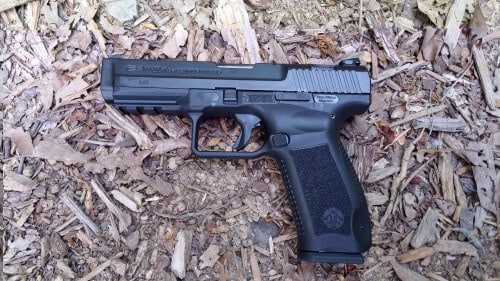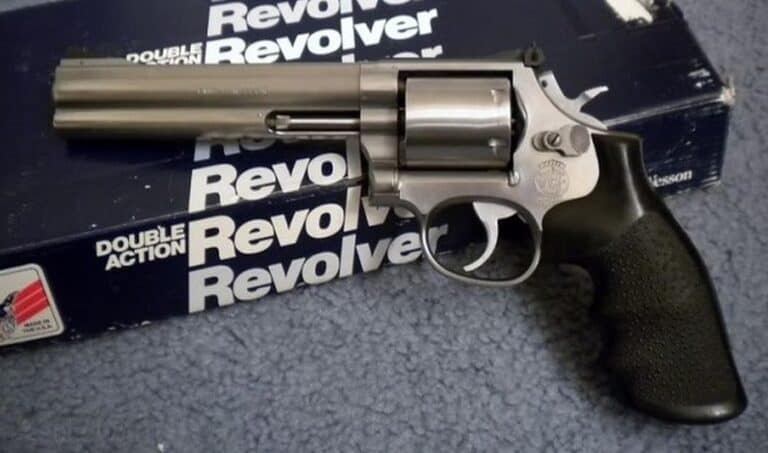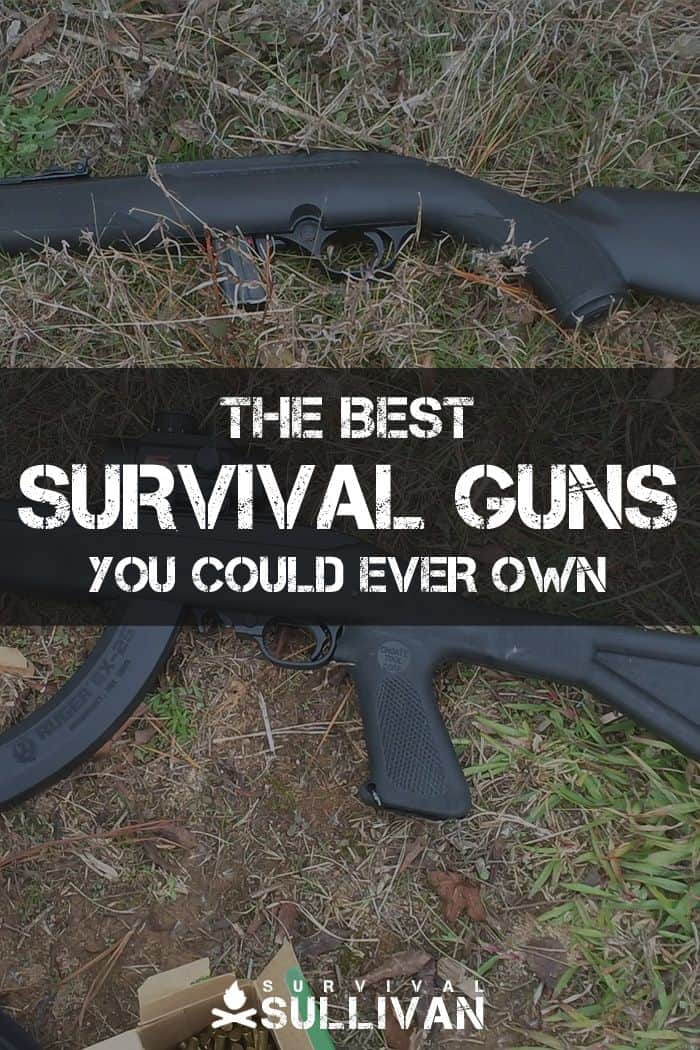One of the most important elements of prepping, along with food, water, and first aid, is security. A disaster scenario will be a dangerous time for you and your family, so you must be prepared to protect them.
In order to do it you must have the necessary tools to do so, and there’s no denying that the weapon of our era is the gun.
While having just one firearm is a major improvement over having no gun, if you really want to complete your survival arsenal, you’ll need several guns, ones specialized for specific purposes.
The best gun for home defense is not necessarily the best gun for hunting, for example.
In this article, I’m going to show you six specific guns that should be in your arsenal, the areas they excel in, and the reasons to own each.
Table of Contents
.22 Semi-Automatic Rifle
The .22 LR is one of the most versatile calibers in the United States today. They’re extremely small cartridges, meaning you can literally buy thousands of rounds of ammo and it will take up very little space.
The low recoil makes it perfect for teaching new people how to shoot as well as for target practice, honing your fundamentals, and just plinking. It’s also the best gun possible for small game hunting and pest control thanks to its relatively low noise, low cost, and reduced penetration.
No survival arsenal is complete without a .22 rifle, specifically a .22 semi-automatic rifle. The top three most common .22 semi-automatic rifles in America today are the Marlin Model 60, the Ruger 10/22, and the Smith & Wesson M&P 15-22.
All three are accurate, and reliable, and can benefit from a wide array of aftermarket parts for you to optimize them as you see fit.
If you’re using an AR-15 as your semi-automatic centerfire rifle (which we’ll talk about later in this article), then it may be wise to select the M&P15-22 because its manual of arms is virtually identical to its centerfire cousin.
This is a benefit when training a newer shooter on one or the other, as well as serving double duty as a low-cost training rifle.
The Marlin and the Ruger also are both great rifles that will also last for a long time. The biggest difference between them is that the Marlin is tube fed while the Ruger accepts traditional detachable magazines. Choose based on your personal preference.
Pump Action Shotgun, 12 or 20 Ga
A good shotgun is the most flexible gun to own, even more so than the .22, because it can truly do it all with a simple change of ammunition: from home defense to signaling and hunting of small or big game and even birds, the shotgun’s versatility is unmatched.
When choosing a shotgun for survival, select one chambered in 12 or 20 gauge. Pump actions will require less upkeep over time, and also will not struggle cycling a varied diet of shotshells like a semi-auto can.
Before you worry over the efficacy of a pump for defense, know that if you practice with a pump action shotgun enough you’ll be able to shoot nearly as fast as you could a semi-auto.
This advice doesn’t mean you should necessarily rule out semi-automatic shotguns completely, but you must understand their limitations, care, and feed before committing.
Pump-action shotguns also generally cost less than a reliable semi-auto. If money is an issue when it comes to your arsenal, a pump-action shotgun should suit you well.
12 and 20 gauge shotshells are both inexpensive and plentiful, which is why they are the only shotgun rounds you should consider. Both also offer a wide variety of loads to serve any purpose. Of the two, 12 gauge offers a larger payload but the trade-off is that it has significantly more recoil.
A 20-gauge is still more than capable of getting the job done when it comes to defense against two-legged critters, so don’t think you’re not well protected if you go with the 20 gauge. If you are worried about the recoil of the 12 for yourself or someone else, by all means, go with the 20 Gauge.
When you’re in the market for a pump action shotgun, the top two models to consider are the Mossberg 500/590 and the Remington 870.
Both of these shotguns have been around for over half a century and are enormously popular with civilians and law enforcement personnel alike.
Not only can you find a used Mossberg or Remington in good condition for a dirt-cheap price, but spare parts and accessories are plentiful for both guns.
A quick tip for each: if selecting one of the Mossbergs, forego the pistol grip stock as the tang-mounted safety will be tough to activate from such a grip.
If choosing a Remington 870, seek out an older Police or Wingmaster model; the newer Express and Tactical lineups are of poor quality owing to Remington’s financial woes.
Some models of the 500/590 and 870 sell with two interchangeable barrels, a short barrel for close-quarters home defense and a longer, vented rib-choked barrel for hunting and clay shooting.
This is a great option for someone wanting to be prepared for all eventualities with one purchase.
Semi-Automatic Pistol

While your pistol should not be your only primary weapon in a disaster situation, it should still be on your hip at all times so that you always have a gun close at hand in the event danger strikes without warning.
There are three crucial criteria that your semi-automatic pistol must meet:
- It must be reliable.
- It must be common enough to ensure spare magazines and parts are widely available.
- It must be chambered in 9mm, .40 S&W, or .45 ACP.
There are other great pistol calibers out there, but these are the three are most available among the most effective.
This means that they’re not only the cheapest to buy now, but you will be far more able to source them in a disaster scenario, too. Also Plan on having a minimum of at least 5 magazines for each pistol.
There are a great many high-quality semi-automatic pistols out there that meet the criteria we have set above. Whatever you choose, make sure that the spare parts are available and affordable. It will be very tough to beat a Glock or M&P on this front.
Another viable choice could be something like a Beretta M9 or 92 series gun, only now being phased out of military service.
1911s and Browning Hi-Powers are great shooting pistols, but their designs are venerable, and require hand-fitting of high quality parts to ensure reliability.
Those secondary skills may not be something in easy reach after the balloon goes up if you yourself do not possess them.

.357 Magnum Revolver, Double Action
You should have at a minimum two handguns in your arsenal so that at least one other person in your group can carry a sidearm also.
Another obvious reason to have a backup is so you can access it easily should the situation arise where your primary sidearm is lost or broken.
While your primary handgun should be a semi-automatic pistol with a healthy magazine capacity, a fine choice for a secondary is a revolver. Specifically a 357 Magnum double action revolver in stainless steel and with a 4-inch barrel.
Why .357 Magnum? Aside from being a potent and flat-shooting cartridge it can also chamber and fire .38 Specials, drastically increasing the versatility of the weapon. .357 Mag has a fair amount of recoil, and a very sharp report, but .38 Specials are noticeably tamer.
This may make it a good choice for a smaller or weaker person in your group, allowing them to more easily shoot the revolver.
I recommended above that the revolver have a stainless-steel finish and a 4-inch barrel. Stainless steel is more corrosion-resistant than bluing and will hold up better in harsh, wet, and humid conditions.
The 4-inch barrel is ideal when firing .357s, as it helps maximize performance while remaining convenient to carry.
Revolvers do however have their disadvantages. They only carry 5-7 rounds, or 8 rounds in some rare examples and they have slow reloading times. On the flip side, however, they are reliable and have a simple manual of arms.
Even if someone in your family doesn’t know how to operate a semi-automatic, they can easily use a revolver because all they have to do is pick it up and pull the trigger.
As far as brands are concerned, the most popular revolver makers in the United States today are Ruger, Smith & Wesson, and Taurus.
Of these, Ruger revolvers are considered the most rugged, Smith & Wesson revolvers are famous for smooth action, and Taurus makes cheap clones of the Smith & Wesson models for the budget minded.
A revolver from any of these brands will serve you well enough as a defensive gun.
Semi-Automatic Rifle
The next gun you should acquire is a semi-automatic, rifle. The purpose of this gun is to provide maximum efficiency in defending your family and property from multiple intruders, though it can also be used for hunting if need be.
While a shotgun is great to have under your bed for home defense, it has some drawbacks that are challenging to overcome: a much lower capacity, more difficult manual of arms, and formidable recoil.
A pistol is great to have on your side or nightstand, but it has limited power and range. A semi-automatic rifle gives you plenty of power, precision, a deep magazine capacity, and long-range for property defense.
As with your pistol, your semi-automatic rifle needs to be completely reliable and made by a reputable company.
It should also have an abundance of spare parts and magazines on the market and should be chambered in common calibers (in this case 5.56x45mm NATO, 5.45x45mm, 7.62x39mm, or 7.62x51mm NATO / .308 Win.).
Examples of semi-automatic rifles that meet these criteria include the AK-47 or AK-74 and variants, AR-15s, Ruger Mini-14 or Mini-30, HK-91 or G3 variants, FALs or M-1As.
Plan on buying at least 5 magazines for your rifles. You don’t need to carry your rifle on your back everywhere you go, but it should still be on standby so you can grab it quickly when needed.
Bolt-Action Rifle, Scoped
The last gun that should be in your arsenal is a scoped bolt-action rifle chambered in .308 Winchester or .30-06 Springfield that can strike a target accurately, whether they be enemy personnel or big game, at longer distances than your semi-automatic rifle can.
You could just as easily install a scope on a semi-automatic rifle chambered in a larger caliber as well, but bolt-actions tend to be more accurate and weigh less than their semi-auto cousins, all things being equal. This is an important consideration for a hunting rifle in particular.
.308 and .30-06 are both highly popular with hunters and shooters and will be plentiful in a post-disaster scenario. They are effective on nearly any game animal in North America at long ranges.
Many major gun manufacturers make a bolt-action rifle of some kind, and most of them will serve well enough, but two of the most reliable ones are the Remington 700 (or 770) and the Winchester Model 70.
Both of these rifles have been around for a very long time, and are still in widespread use today. They are simple to use, accurate and well-built.
I recommend that you buy either a stainless steel or all-weather finished model in a synthetic stock, rather than traditional blue in a wood stock, as thus will hold up better in harsh climate conditions.
Don’t forget to factor in the cost of installing a high-quality scope in correspondingly good mounts on your as well! Don’t settle for a cheap scope or rings: your rifle will only be as accurate as its least accurate component (this includes YOU!) .
Make the investment and buy a proven scope from a reputable company such as Bushnell, Leupold, or Nikon, one with excellent clarity, light transmission, and ruggedness. Cheaper scopes tend to fog up very quickly or lose zero.
Conclusion
After you buy all of the guns you will need there are two more items on your action list:
- buy and store plenty of ammo and
- practice, practice, practice.
As a general rule of thumb, you should have at least 1,000 rounds of ammo per caliber stored away that you will only access when disaster strikes, and at least 500-1,000 rounds ready for training purposes.
It certainly doesn’t come cheap. One strategy you can use for accumulating the ammo you need without breaking your wallet is to make it a habit to buy 2-3 boxes every week and to focus on buying one caliber at a time. You will be amazed at how fast your stockpile of ammo grows.
Finally, practice with your guns extensively. It’s always wiser to spend your money on ammo for training than it is to spend money on accessories for your guns so that they ‘look cool.’
You should know how to field strip each of your guns and put them back together again and you also must be able to shoot them accurately, conduct reloads, and clear malfunctions so you can get back in the fight quickly.
Take the time and sign up for training classes and put plenty of rounds downrange in practice. All the guns in the world will do no good if there is not a proficient shooter behind the trigger.


Nick Oetken is a prepper, outdoor enthusiast but, most of all, he is our in-house firearms expert. Look out for his articles on guns to find out which ones you need for your survival.

Good article!
Succinct, concise, and to the point.
All weapon suggestions are well thought out and, more importantly, available to most Americans.
Excellent article with practical information. All are common calibers and fairly inexpensive.
One thing that I failed to read was a good cleaning kit with components to fit each caliber. Spare components are a big plus. Hard to clean a .22 with a .30-06 brush. lol
This is a fairly good article. Buf the reality is if things get that bad where this is our way to survive In my mind everyone in my group should have a Ruger LCP2 in their pocket. Everyone an armed defender…. no its not the best pistol but it will work at inside distances and at 179$ each the LCP2 makes a lot of sense. There is a good video on youtube of the LCP2 shot at 10 yards (30feet) which is bad news for an intruder. And loaded with underwood xtreme penetrators they are formidable.